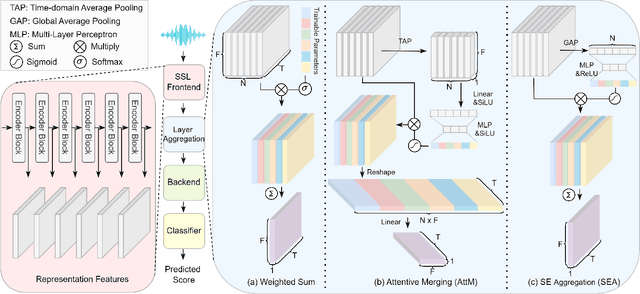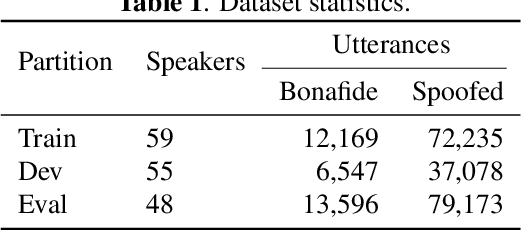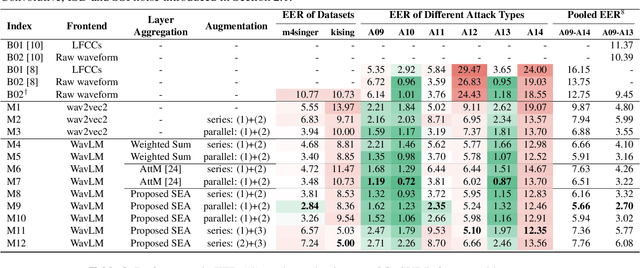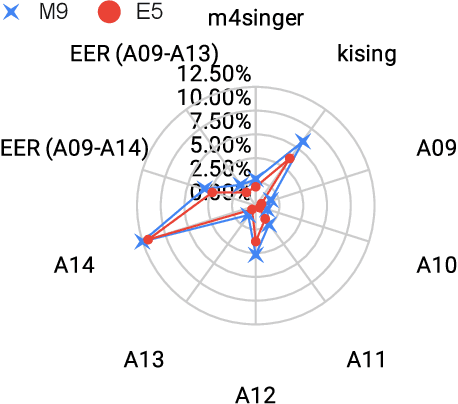Qiongqiong Wang
MERaLiON-SpeechEncoder: Towards a Speech Foundation Model for Singapore and Beyond
Dec 20, 2024Abstract:This technical report describes the MERaLiON-SpeechEncoder, a foundation model designed to support a wide range of downstream speech applications. Developed as part of Singapore's National Multimodal Large Language Model Programme, the MERaLiON-SpeechEncoder is tailored to address the speech processing needs in Singapore and the surrounding Southeast Asian region. The model currently supports mainly English, including the variety spoken in Singapore. We are actively expanding our datasets to gradually cover other languages in subsequent releases. The MERaLiON-SpeechEncoder was pre-trained from scratch on 200,000 hours of unlabelled speech data using a self-supervised learning approach based on masked language modelling. We describe our training procedure and hyperparameter tuning experiments in detail below. Our evaluation demonstrates improvements to spontaneous and Singapore speech benchmarks for speech recognition, while remaining competitive to other state-of-the-art speech encoders across ten other speech tasks. We commit to releasing our model, supporting broader research endeavours, both in Singapore and beyond.
Towards a Speech Foundation Model for Singapore and Beyond
Dec 16, 2024Abstract:This technical report describes the MERaLiON Speech Encoder, a foundation model designed to support a wide range of downstream speech applications. Developed as part of Singapore's National Multimodal Large Language Model Programme, the MERaLiON Speech Encoder is tailored to address the speech processing needs in Singapore and the surrounding Southeast Asian region. The model currently supports mainly English, including the variety spoken in Singapore. We are actively expanding our datasets to gradually cover other languages in subsequent releases. The MERaLiON Speech Encoder was pre-trained from scratch on 200K hours of unlabelled speech data using a self-supervised learning approach based on masked language modelling. We describe our training procedure and hyperparameter tuning experiments in detail below. Our evaluation demonstrates improvements to spontaneous and Singapore speech benchmarks for speech recognition, while remaining competitive to other state-of-the-art speech encoders across ten other speech tasks. We commit to releasing our model, supporting broader research endeavours, both in Singapore and beyond.
Towards Quantifying and Reducing Language Mismatch Effects in Cross-Lingual Speech Anti-Spoofing
Sep 12, 2024Abstract:The effects of language mismatch impact speech anti-spoofing systems, while investigations and quantification of these effects remain limited. Existing anti-spoofing datasets are mainly in English, and the high cost of acquiring multilingual datasets hinders training language-independent models. We initiate this work by evaluating top-performing speech anti-spoofing systems that are trained on English data but tested on other languages, observing notable performance declines. We propose an innovative approach - Accent-based data expansion via TTS (ACCENT), which introduces diverse linguistic knowledge to monolingual-trained models, improving their cross-lingual capabilities. We conduct experiments on a large-scale dataset consisting of over 3 million samples, including 1.8 million training samples and nearly 1.2 million testing samples across 12 languages. The language mismatch effects are preliminarily quantified and remarkably reduced over 15% by applying the proposed ACCENT. This easily implementable method shows promise for multilingual and low-resource language scenarios.
Speech Foundation Model Ensembles for the Controlled Singing Voice Deepfake Detection (CtrSVDD) Challenge 2024
Sep 03, 2024



Abstract:This work details our approach to achieving a leading system with a 1.79% pooled equal error rate (EER) on the evaluation set of the Controlled Singing Voice Deepfake Detection (CtrSVDD). The rapid advancement of generative AI models presents significant challenges for detecting AI-generated deepfake singing voices, attracting increased research attention. The Singing Voice Deepfake Detection (SVDD) Challenge 2024 aims to address this complex task. In this work, we explore the ensemble methods, utilizing speech foundation models to develop robust singing voice anti-spoofing systems. We also introduce a novel Squeeze-and-Excitation Aggregation (SEA) method, which efficiently and effectively integrates representation features from the speech foundation models, surpassing the performance of our other individual systems. Evaluation results confirm the efficacy of our approach in detecting deepfake singing voices. The codes can be accessed at https://github.com/Anmol2059/SVDD2024.
Attentive Merging of Hidden Embeddings from Pre-trained Speech Model for Anti-spoofing Detection
Jun 12, 2024Abstract:Self-supervised learning (SSL) speech representation models, trained on large speech corpora, have demonstrated effectiveness in extracting hierarchical speech embeddings through multiple transformer layers. However, the behavior of these embeddings in specific tasks remains uncertain. This paper investigates the multi-layer behavior of the WavLM model in anti-spoofing and proposes an attentive merging method to leverage the hierarchical hidden embeddings. Results demonstrate the feasibility of fine-tuning WavLM to achieve the best equal error rate (EER) of 0.65%, 3.50%, and 3.19% on the ASVspoof 2019LA, 2021LA, and 2021DF evaluation sets, respectively. Notably, We find that the early hidden transformer layers of the WavLM large model contribute significantly to anti-spoofing task, enabling computational efficiency by utilizing a partial pre-trained model.
Cosine Scoring with Uncertainty for Neural Speaker Embedding
Mar 11, 2024Abstract:Uncertainty modeling in speaker representation aims to learn the variability present in speech utterances. While the conventional cosine-scoring is computationally efficient and prevalent in speaker recognition, it lacks the capability to handle uncertainty. To address this challenge, this paper proposes an approach for estimating uncertainty at the speaker embedding front-end and propagating it to the cosine scoring back-end. Experiments conducted on the VoxCeleb and SITW datasets confirmed the efficacy of the proposed method in handling uncertainty arising from embedding estimation. It achieved improvement with 8.5% and 9.8% average reductions in EER and minDCF compared to the conventional cosine similarity. It is also computationally efficient in practice.
* 5 pages, 4 figures
Golden Gemini is All You Need: Finding the Sweet Spots for Speaker Verification
Dec 06, 2023Abstract:Previous studies demonstrate the impressive performance of residual neural networks (ResNet) in speaker verification. The ResNet models treat the time and frequency dimensions equally. They follow the default stride configuration designed for image recognition, where the horizontal and vertical axes exhibit similarities. This approach ignores the fact that time and frequency are asymmetric in speech representation. In this paper, we address this issue and look for optimal stride configurations specifically tailored for speaker verification. We represent the stride space on a trellis diagram, and conduct a systematic study on the impact of temporal and frequency resolutions on the performance and further identify two optimal points, namely Golden Gemini, which serves as a guiding principle for designing 2D ResNet-based speaker verification models. By following the principle, a state-of-the-art ResNet baseline model gains a significant performance improvement on VoxCeleb, SITW, and CNCeleb datasets with 7.70%/11.76% average EER/minDCF reductions, respectively, across different network depths (ResNet18, 34, 50, and 101), while reducing the number of parameters by 16.5% and FLOPs by 4.1%. We refer to it as Gemini ResNet. Further investigation reveals the efficacy of the proposed Golden Gemini operating points across various training conditions and architectures. Furthermore, we present a new benchmark, namely the Gemini DF-ResNet, using a cutting-edge model.
Disentangling Voice and Content with Self-Supervision for Speaker Recognition
Oct 02, 2023Abstract:For speaker recognition, it is difficult to extract an accurate speaker representation from speech because of its mixture of speaker traits and content. This paper proposes a disentanglement framework that simultaneously models speaker traits and content variability in speech. It is realized with the use of three Gaussian inference layers, each consisting of a learnable transition model that extracts distinct speech components. Notably, a strengthened transition model is specifically designed to model complex speech dynamics. We also propose a self-supervision method to dynamically disentangle content without the use of labels other than speaker identities. The efficacy of the proposed framework is validated via experiments conducted on the VoxCeleb and SITW datasets with 9.56% and 8.24% average reductions in EER and minDCF, respectively. Since neither additional model training nor data is specifically needed, it is easily applicable in practical use.
Generalized domain adaptation framework for parametric back-end in speaker recognition
May 24, 2023Abstract:State-of-the-art speaker recognition systems comprise a speaker embedding front-end followed by a probabilistic linear discriminant analysis (PLDA) back-end. The effectiveness of these components relies on the availability of a large amount of labeled training data. In practice, it is common for domains (e.g., language, channel, demographic) in which a system is deployed to differ from that in which a system has been trained. To close the resulting gap, domain adaptation is often essential for PLDA models. Among two of its variants are Heavy-tailed PLDA (HT-PLDA) and Gaussian PLDA (G-PLDA). Though the former better fits real feature spaces than does the latter, its popularity has been severely limited by its computational complexity and, especially, by the difficulty, it presents in domain adaptation, which results from its non-Gaussian property. Various domain adaptation methods have been proposed for G-PLDA. This paper proposes a generalized framework for domain adaptation that can be applied to both of the above variants of PLDA for speaker recognition. It not only includes several existing supervised and unsupervised domain adaptation methods but also makes possible more flexible usage of available data in different domains. In particular, we introduce here two new techniques: (1) correlation-alignment in the model level, and (2) covariance regularization. To the best of our knowledge, this is the first proposed application of such techniques for domain adaptation w.r.t. HT-PLDA. The efficacy of the proposed techniques has been experimentally validated on NIST 2016, 2018, and 2019 Speaker Recognition Evaluation (SRE'16, SRE'18, and SRE'19) datasets.
Incorporating Uncertainty from Speaker Embedding Estimation to Speaker Verification
Feb 23, 2023Abstract:Speech utterances recorded under differing conditions exhibit varying degrees of confidence in their embedding estimates, i.e., uncertainty, even if they are extracted using the same neural network. This paper aims to incorporate the uncertainty estimate produced in the xi-vector network front-end with a probabilistic linear discriminant analysis (PLDA) back-end scoring for speaker verification. To achieve this we derive a posterior covariance matrix, which measures the uncertainty, from the frame-wise precisions to the embedding space. We propose a log-likelihood ratio function for the PLDA scoring with the uncertainty propagation. We also propose to replace the length normalization pre-processing technique with a length scaling technique for the application of uncertainty propagation in the back-end. Experimental results on the VoxCeleb-1, SITW test sets as well as a domain-mismatched CNCeleb1-E set show the effectiveness of the proposed techniques with 14.5%-41.3% EER reductions and 4.6%-25.3% minDCF reductions.
 Add to Chrome
Add to Chrome Add to Firefox
Add to Firefox Add to Edge
Add to Edge